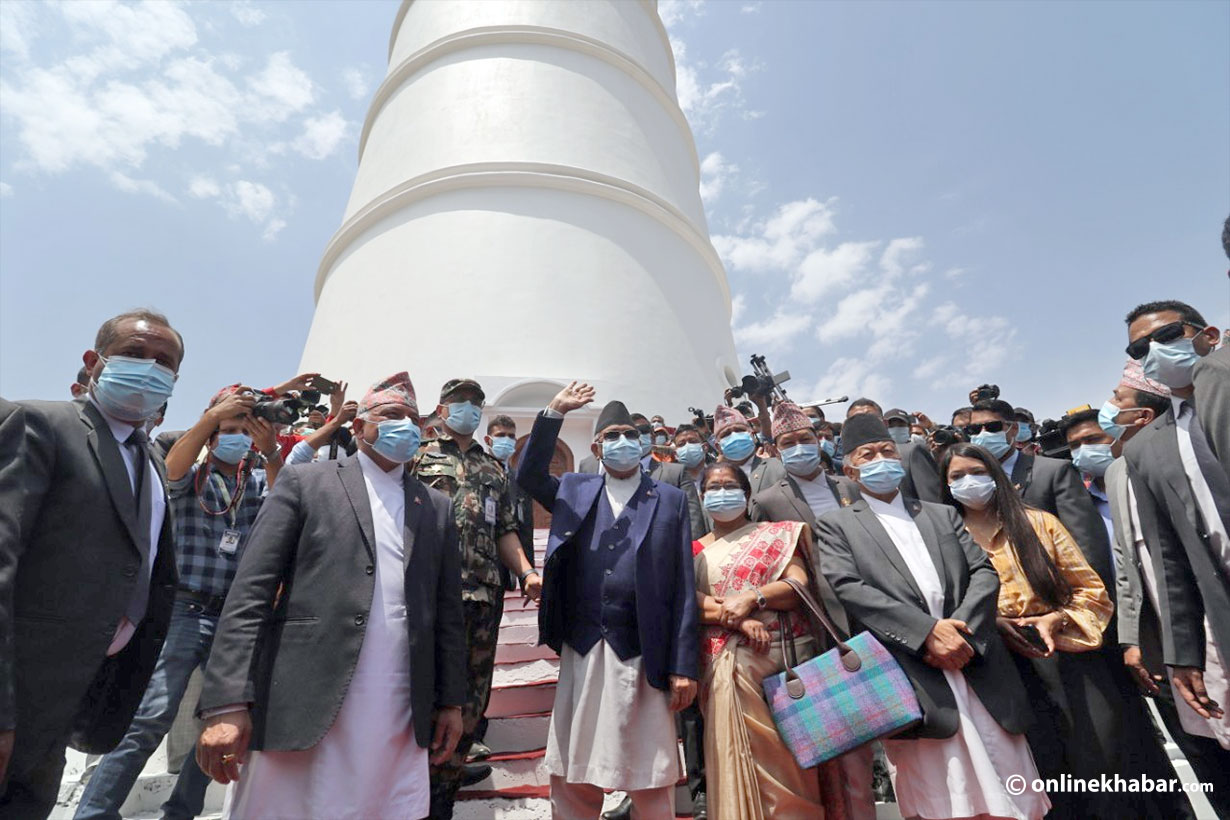As the nation fights hard to save the citizens from the Covid-19 pandemic, Prime Minister KP Sharma Oli has been busy travelling all over Nepal for the past several months. He has not been travelling to monitor Nepal’s Covid-19 response. Instead, he has been visiting various districts to inaugurate buildings, attend party meetings and lay foundation stones.
Since March 2021, Oli has laid the foundation stones for the projects that cost more than Rs 400 billion.
During his visit, he often talks about how a wave of development is coming in Nepal. But, almost all the projects that he officially launched have not actually started due to the lack of proper planning while those that have are being constructed at a snail’s pace.
Pandemic on the periphery
Even though much of the budget for the fiscal year 2020/21 was set for fighting the pandemic, the government’s interest was in starting projects for which funds had not been set aside and inaugurating the projects that were yet to be completed. This is raised a question if the government ever had interest in making sure that it was ready to fight the pandemic.
In the past three months, government officials have inaugurated roads, bridges, industrial estates and irrigation canals. Most of them have plaques with Oli’s name on them. While he personally went to lay the foundation stone in many projects, some of them were done by pressing a switch at the PM’s residence in Balwatar itself.
According to the government, most of these projects are going to be completed with the help of foreign direct investment (FDI) while it is yet to allocate a budget to the rest. Many projects are in limbo as the government is preparing for loans from other countries to complete it.
The length of these projects is between two to five years, according to the government, and will cost around Rs 400 billion. However, a budget of only Rs 2 billion was set aside for these projects in the ongoing fiscal year with an additional 11.75 billion coming from the FDI.
Getting nowhere
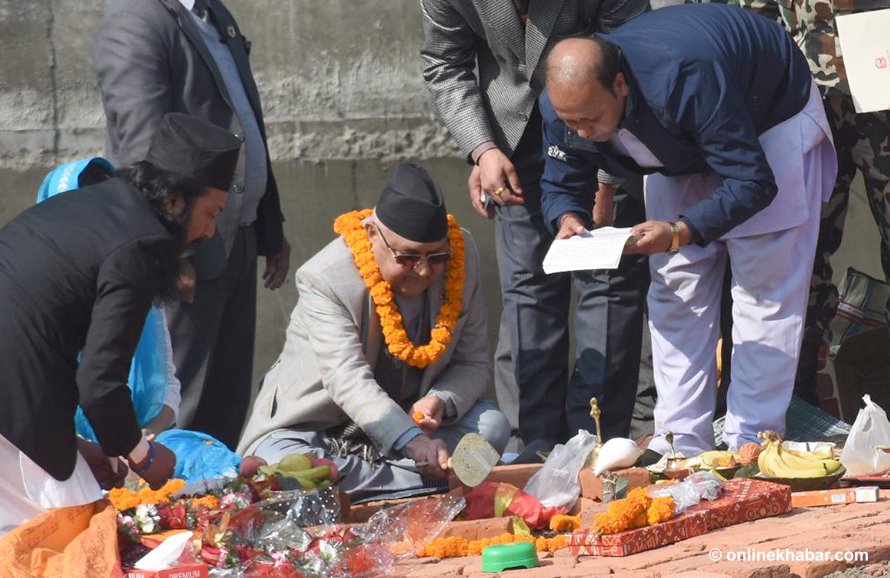
But, most of the project which needs funds have not done their homework, say experts. Most have yet to do a detailed project report (DPR) while others have yet to purchase land for the project. These projects have not done an environmental assessment while most are waiting for permission for site clearance. Road construction projects are in such an unplanned state that the route from where the road passes has not been finalised in some cases.
Experts from the infrastructure field say that the government laying foundation stones to start these projects despite knowing that it lacks planning is concerning. They say that this trend has not stopped despite being warned by experts.
According to Nepal’s law, the contractor who is assigned the project needs to reach the site within 15 days of having taken the mobilisation fund. But most of the time, the area where work needs to be done is obstructed by one thing or another. Sometimes it is the locals while other times it is the government itself. When that happens, the government cannot take any action against the contractor as the role of site clearance is the governments. Instead, these contractors can claim compensation from the government for wasting their time.
Despite knowing this, the government and Oli continue to lay the foundation stones to start these projects. Little to nothing has been done since he laid the foundation stone in most of the projects. That is not it; he has also inaugurated projects which are yet to be complete. This, according to officials from the Ministry of Transport and Infrastructure, is wrong as it might affect the quality of work.
A project is under the responsibility of the contractor until it is handed over to the government or concerned body. By inaugurating it before it is over, the government itself invites the risk of substandard work. It also raises concern about the government accepting the project afterwards.
“There is a rush to inaugurate a project even though it’s not ready. Due to that, contractors work in a hurry as they have a deadline which, they claim, affects the standard of work,” says the official asking to remain anonymous.
Corruption and conflict of interest
Procurement and contract management expert Rajendra Prasad Adhikari says that when the government inaugurates projects, it implies that the project has been handed over to the government even though it is not the case.
“It’s a matter of good governance. This nature of inaugurating incomplete projects before it is completed will cause problem throughout the country as it will surely affect the quality of work done on the project,” says Adhikari.
Adhikari further adds questions should also be raised about who gives the money to host these programmes as no fund is allocated to host such programmes. He says that corruption can happen as a result of this as the contractor can ask for whatever money they need. If the contractors conduct the event themselves, the question about the conflict of interest also arises.
“These issues should be looked at carefully by the Office of the Auditor General,” says Adhikari. “These events obstruct work for a few days because it is not easy preparing for these inaugurations. A lot of things need to be done. As I see it, it just gives the contractors an excuse to delay work.”
He says that Oli or any other minister should refrain from doing so as it mocks the entire notion of project completion along with the health and safety of everyone present there.
Adhikari also adds that due to the government and its agencies not planning projects properly, things are getting out of hand in managing the projects. An example is the Khokona case in which locals continuously protest about the road that is due to displace a part of the old Newa settlement south of Kathmandu.
“The National Development Committee which is chaired by the PM Oli talks a lot about these issues. But, they continue to make the same mistake year in, year out; it feels like a joke,” says Adhikari.
Legislators’ executive role
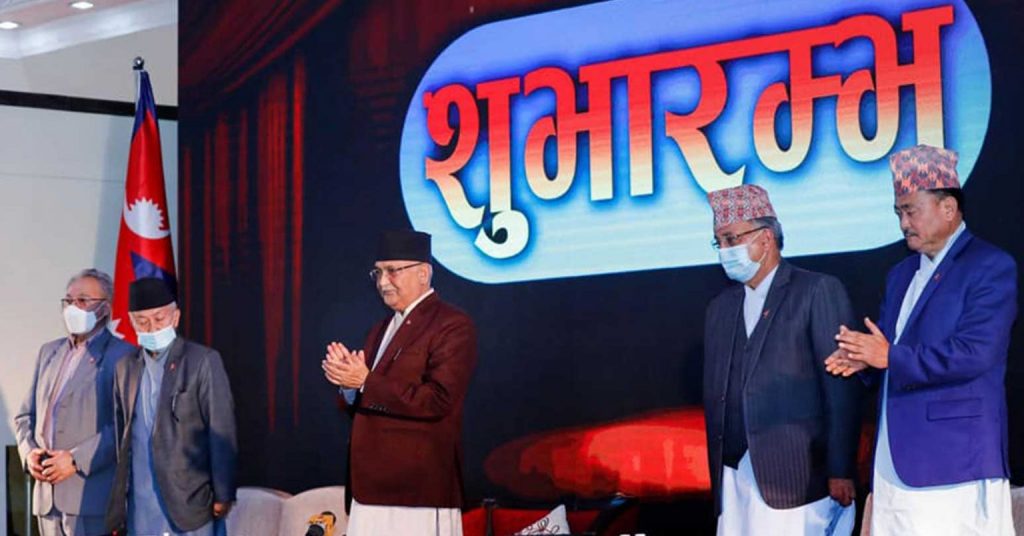
On April 3, Oli at the PM’s residence in Balwatar pressed a switch to inaugurate a programme under which all 165 federal constituencies would have proper roads in the next three years. After members of the House of Representatives asked for an improved development budget, the Finance Ministry for the current fiscal year added a budget of Rs 3.2 billion specifically to construct roads in these constituencies. But, even though the programme was launched, there has been no planning about how the roads will be constructed in these areas.
Out of the 165, a total of 110 of these constituencies are yet to submit a detailed project report (DPR) for the roads. Many have not even done the environmental impact assessment, which is important as most of them fall in the hilly areas which are susceptible to landslides in the monsoon.
The spokesperson at the Department of Roads, Shiva Prasad Nepal, says that work will be done only in the 55 constituencies whose DPR is complete.
“We’ll start the rest after they submit their DPR and EIA report,” says Nepal. “Some projects might start this yea,r but it’s quite evident that 90 per cent will only start next fiscal year.”
The government plans to pave around 2,200 kilometre roads in the next three years for which it has to set aside a whooping Rs 57 billion.
“That’s going to be a major problem,” says Nepal.
Sunkoshi Diversion
On March 4, Oli launched the Sunkoshi Diversion project. But the work for the project, according to the Department of Irrigation, will begin only next year. The Rs 10.05-billion project will likely be given to the Chinese Overseas Engineering Group. After its design is passed by the Department of Irrigation, the company will have to purchase a tunnel boring machine. But, the department’s Director-General Madhukar Rajbhandari says that it is unlikely that a tunnel will be dug this year.
The total cost of the project is likely to be around Rs 46 billion. But, sources say that only Rs 16 billion has been allocated to the project so far.
Strategic roads sans strategy of construction
On March 14, Oli also laid the foundation stone for a provincial level programme that aims to construct and manage roads across provinces. The aim of the programme is to construct roads in 228 local units throughout the country. But, like other projects, preparation for this one too is little to none.
Most local governments are yet to decide the route while most have not prepared the DPR and EIA report. The total cost of the project is estimated to be Rs 200 billion, but only Rs 5 billion has been set aside for the project in the current fiscal year. The government has aimed to find a development partner who could provide an aid of Rs 4 billion. But as of May, there is no hope.
To complete the project, the government has to pave around 4,000 kilometres of road and construct an additional 400 bridges. For this, all three federal, provincial and local governments will set aside a budget for the project. The spokesperson of Department of Local Infrastructure, Hom Nath Poudel, says that talks are being held with the Finance Ministry to get the gunds.
“We’ve started our basic preparation to prepare the DPR. Areas whose DPR is already ready will be reassessed as it’s unlikely that any work will begin before the next fiscal year,” says Poudel.
Industrial estates without preparation
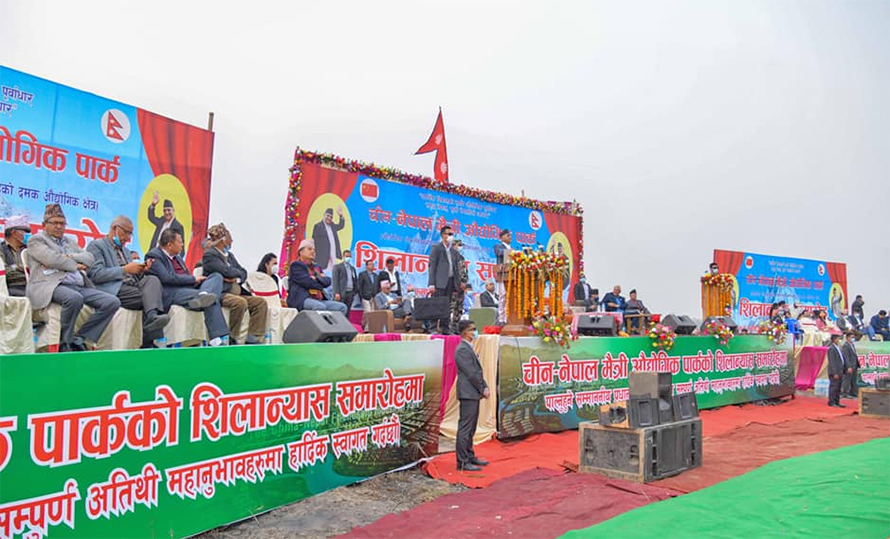
Oli in February laid the foundation stones to start four different industrial estates in Kanchanpur, Banke, Makawanpur and Jhapa. Similarly, in March, Finance Minister Bishnu Poudel and Minister for Industry and Commerce Lekh Raj Bhatta, despite local protest, laid the foundation stone to start industrial estate in Rupandehi.
It is estimated that a total of Rs 100 billion will be needed to construct these estates. When the foundation stones were laid for these five projects, only one had secured the funds for construction. But, none of these projects has a contractor yet.
The Industrial District Management Limited says that three of the five will be constructed with funds provided by the Nepal government. Out of the remaining two, one will be assigned to a Chinese company while one will be assigned to a development partner.
The industrial park in Damak will be constructed with the help of Chinese investment worth Rs 64 billion. But to date, the government has received only Rs 2 billion. The rest of the industrial estates will need at least Rs 26 billion.
ALSO READ:
The Industrial District Management Limited says Rs 7.2 billion is required to construct the estate in Makawanpur, Rs 8.77 for the estate in Banke and Rs 9 billion for Kanchanpur. However, an EIA report and a DPR have not been done in any of these areas.
The Rs 12-billion project in Rupandehi, however, is facing problems due to locals not agreeing to sell their land. This project is also expecting the FDI, but how that will happen remains to be seen.
The Industrial District Management Limited’s chairman Nanda Kishor Basnet calls the laying of foundation stones a new trend.
“It creates a good environment. Don’t think it’s wrong,” says Basnet.
Basnet says that the National Planning Commission has approved these projects. But, even though Rs 1 billion was set aside this year for it, it is clear that this money will not be spent on development or construction work.
“We’ve asked for Rs 1.1 billion to start work on the estates in Daiji, Motipur and Nauwasta. We’ll spend Rs 200 million on each of these projects in the coming fiscal year,” he says. “The money will be used to flatten the ground, pave roads and set up an electricity system.”
No design for new bridges
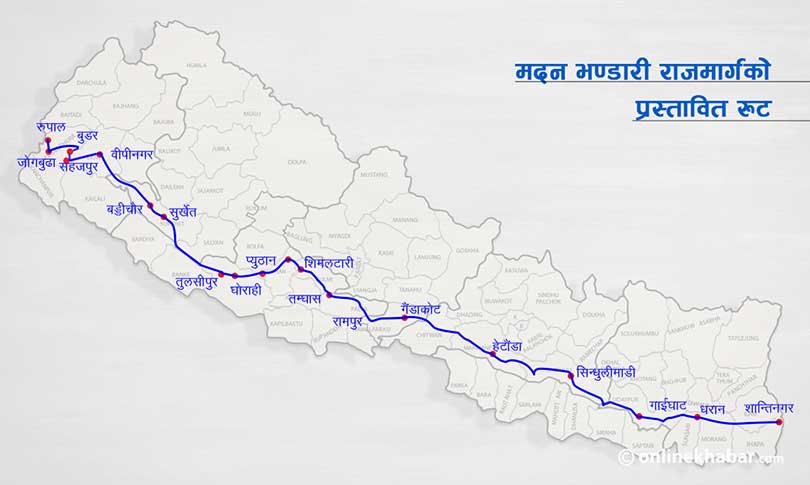
There are other projects Oli has been launching since the turn of the year. On February 28, he launched the project of constructing bridges along the Madan Bhandari Highway. There are 31 bridges to be built along the highway. But, the Department of Roads is yet to receive a design for these bridges. Prior planning is also missing on the project, say experts.
The chief of the Madan Bhandari Highway Project Directorate, Umesh Bindu Shrestha, says that the project has already been assigned to the contractors on the ‘design and build’ model. Shrestha says that the contractors have started to design the bridges now.
To construct these bridges, the project directorate has selected 13 construction companies that will work with a budget of Rs 6 billion.
“Some designs have been accepted and work has started. The rest are working on the design,” says Shrestha.
Even though the bridge construction project was launched, work on paving the road with tarmac is yet to be done as the directorate has not found a contractor yet. This means that in certain sections, a bridge will be ready before the road is.
“We’ve called a tender for the 65 kilometres. The rest will be called in the coming fiscal year,” says Shrestha.
Melamchi inaugurated by disregarding protocol

After over two decades, Melamchi’s water finally arrived in Kathmandu. But, works on the project are still ongoing.
Minister for Drinking Water and Sanitation Mani Thapa on February 22 pressed a switch at Ambathan, Sindupalchok to fill the tunnel with water. Twelve days later, on March 6, Oli pressed a switch to release the water into the Bagmati river.
On March 28, the officials of Kathmandu Upatyaka Kahanepani Limited (KUKL) started distributing the water to the denizens of the valley while on April 2, President Bidya Devi Bhandari opened a tap at Bhrikutimandap to officially declare that Melamchi’s water had arrived in Kathmandu.
Looking at the way the project was celebrated, it looked like everything had been completed. But, officials say that construction works at a dam and a descender are still ongoing. The project’s chief Tiresh Kumar Khatri says that it will take another year for the project to be 100 per cent complete.
That proves the inauguration was done in haste. What is worrying is the people even disregarded the security protocols that were in place. According to the protocol, the water in the tunnel should have been tested by releasing the water through the flushing tunnel located in Gyalthum, Ambathan, Sindhu and Sundarijal in order to check if it was safe and ready. But, this was not done as the water was directly released to Kathmandu.
ALSO READ:
The chairman of Nepal Tunneling Association, Gyanendra Lal Shrestha, says that to testing might be a problem later on.
“I know the tunnel is only two-kilometre long. But, we had to see how it reacts when filled with water. That way, we would know where the tunnel’s delicate areas were. As they haven’t tested it, we’ll have to wait and watch if the tunnel is strong enough and hope no accidents happen due to it.”
He says that the testing was necessary to see how the soft stones in parts of the tunnel reacted when filled with water. Many from the field say that the protocol was disregarded as Oli wanted to take credit that Melamchi arrived in Kathmandu during his time.
The incomplete view tower
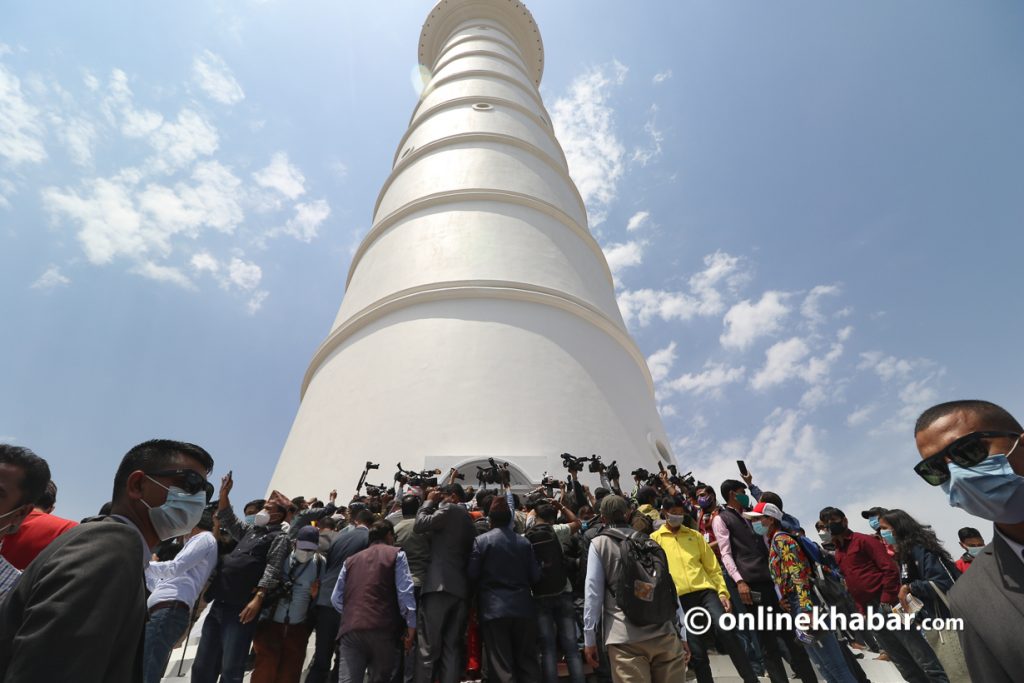
As Nepal was being hit by the second wave of Covid-19, Oli was busy inaugurating the Dharahara which is still incomplete. The lift, which was used by the construction workers, was removed for that day alone as it is being put back again. To make sure it looked good on the photo, the surrounding area of Dharahara was covered with cloths while at the entrance, a red carpet waited for the premier of the country.
Even people associated with constructing the tower say that they do not know when it will be open to the regular public. According to Raju Man Manandhar, engineer at Nepal Reconstruction Authority, around 40 per cent of work is remaining.
Raman Construction is currently working on basement parking, a garden and a museum. Covering the remains of the old Dharahara still needs to be done.
ALSO READ:



